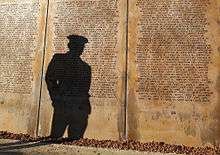International Bomber Command Centre
Coordinates: 53°12′50″N 0°31′51″W / 53.2139°N 0.53095°W
.jpg) Aerial view of the IBCC site in Nov 2015 | |
| Abbreviation | IBCC |
|---|---|
| Formation | 2011 |
| Type | charity |
| Purpose | To relate the stories and experiences of the personnel of Bomber Command during the Second World War. |
| Headquarters | Lincoln, UK |
| Leader | Tony Worth |
Main organ | Lincolnshire Bomber Command Memorial Trust |
| Affiliations | University of Lincoln |
| Website | Official website |
The International Bomber Command Centre (IBCC), on Canwick Hill overlooking the City of Lincoln in England, will be a facility and memorial relating the historical impact of Bomber Command in Lincolnshire during the Second World War.
Lincolnshire Bomber Command Memorial Trust
The project is run by the Lincolnshire Bomber Command Memorial Trust (a registered charity), who in partnership with the University of Lincoln, is scheduled to fully open the centre in 2017.
Objectives
The aim of the IBCC is to tell the personal stories of members of the RAF Bomber Command, ground crew and civilians impacted by the bombing campaigns during the Second World War. The centre will also provide a comprehensive record of the role of Bomber Command's squadrons and to display historical documentation and photographs relating to the activity of Bomber Command.[1]
Digital Archive
The IBCC is creating a digital archive on Bomber Command integrating oral histories, photographs, diaries, letters and service records much of which has never been available for public access. The archive will also reference other digital archives and will work with a wide variety of institutions worldwide to digitise their physical archives.
The IBCC is contacting institutions around the world to create a Bomber Command Digital Archive. The aim is bring photographs, log books and documentation together from all countries that had representatives within Bomber Command.
Funding
The Heritage Lottery Fund contributed £3.1million of funding towards the £10million cost of building the centre.[2][3]
Canwick Hill site
Location

The city of Lincoln was selected for the location of the IBCC because 27 Royal Air Force bases (over a third of all Bomber Command stations) were based in the county during World War II. The large amount of airfields led to Lincolnshire being nicknamed the "Bomber County".
Located at Canwick Hill, the centre will be just under two and half miles from RAF Waddington, which suffered the greatest losses of any Bomber Command station,[1] and close to the former Avro aircraft production facility at Bracebridge Heath. A view of Lincoln Cathedral, a prominent landmark for air crew, forms an important part of the vista from the centre.[4]
The Spire Memorial


Within the grounds of the International Bomber Command Centre the Spire Memorial was erected on 10 May 2015.[5] The memorial is a spire, reflecting the connection to Lincoln Cathedral. It is based on the dimensions of the wing of a Lancaster bomber, being 102 ft (31.09 m) high and 16 ft (5 m) at the base. The Spire was officially unveiled in October 2015.
The spire will be encircled by walls carrying the names of 26,500 men who lost their lives serving in Bomber Command's 1 and 5 Groups. These engraved walls are scheduled to be completed in September 2015. Eventually, the names of all 55,573 who gave their lives whilst serving in Bomber Command will be built and the research for this section has already started.
The Chadwick Centre
Named after Roy Chadwick, the designer of the Lancaster bomber, the International Bomber Command Centre (IBCC) will be an education centre, exhibition space, reference library, artworks and museum relating the story of Bomber Command. The centre will relate the experiences of service personnel in Bomber Command and the effects of bombing on civilian populations. The centre will also cover both the war time and post-war review of the bombing campaigns undertaken during the Second World War.[6]
The centre aims to collect personal experiences of air force veterans from around the world, as well as from civilians impacted by the bombing campaigns and the impact on Lincolnshire of having so many RAF personnel arrive.
International Peace Garden
A landscaped garden will surround the centre to honour the 60 nations that saw service within Bomber Command. The centre, in conjunction with the British Council, is running an international competition to find artists aged 18 to 25 (similar to the average age of Bomber Command personnel) to create artwork for the park.
See also
References
- 1 2 "International Bomber Command Centre". International Bomber Command Centre. Retrieved 25 April 2015.
- ↑ "Bomber Command Centre gets wings with £3.1million from Heritage Lottery Fund". Heritage Lottery Fund. Retrieved 25 April 2015.
- ↑ "Bomber Command Centre gets wings with £3.1 million from Heritage Lottery Fund". University of Lincoln. Retrieved 25 April 2015.
- ↑ "International Bomber Command Centre". Visit Lincoln. Retrieved 25 April 2015.
- ↑ Emily Norton (10 May 2015). "New Lincoln landmark as Bomber Command spire is assembled". Stonebow Media Ltd. Retrieved 13 May 2015.
- ↑ "History in the making as work starts on Lincoln Bomber Command centre". Stonebow Media Ltd. Retrieved 25 April 2015.